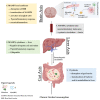Gut Microbiota at the Intersection of Alcohol, Brain, and the Liver
- PMID: 33540624
- PMCID: PMC7867253
- DOI: 10.3390/jcm10030541
Gut Microbiota at the Intersection of Alcohol, Brain, and the Liver
Abstract
Over the last decade, increased research into the cognizance of the gut-liver-brain axis in medicine has yielded powerful evidence suggesting a strong association between alcoholic liver diseases (ALD) and the brain, including hepatic encephalopathy or other similar brain disorders. In the gut-brain axis, chronic, alcohol-drinking-induced, low-grade systemic inflammation is suggested to be the main pathophysiology of cognitive dysfunctions in patients with ALD. However, the role of gut microbiota and its metabolites have remained unclear. Eubiosis of the gut microbiome is crucial as dysbiosis between autochthonous bacteria and pathobionts leads to intestinal insult, liver injury, and neuroinflammation. Restoring dysbiosis using modulating factors such as alcohol abstinence, promoting commensal bacterial abundance, maintaining short-chain fatty acids in the gut, or vagus nerve stimulation could be beneficial in alleviating disease progression. In this review, we summarize the pathogenic mechanisms linked with the gut-liver-brain axis in the development and progression of brain disorders associated with ALD in both experimental models and humans. Further, we discuss the therapeutic potential and future research directions as they relate to the gut-liver-brain axis.
Keywords: alcohol; alcoholic liver disease; bacterial metabolites; gut–liver–brain axis.
Conflict of interest statement
The authors declare no conflict of interest.
Figures
Similar articles
-
The Role of Gut Bacteria and Fungi in Alcohol-Associated Liver Disease.Front Med (Lausanne). 2022 Mar 3;9:840752. doi: 10.3389/fmed.2022.840752. eCollection 2022. Front Med (Lausanne). 2022. PMID: 35308525 Free PMC article. Review.
-
The gut-liver-kidney axis: Novel regulator of fatty liver associated chronic kidney disease.Pharmacol Res. 2020 Feb;152:104617. doi: 10.1016/j.phrs.2019.104617. Epub 2019 Dec 24. Pharmacol Res. 2020. PMID: 31881272 Review.
-
Alcohol or Gut Microbiota: Who Is the Guilty?Int J Mol Sci. 2019 Sep 14;20(18):4568. doi: 10.3390/ijms20184568. Int J Mol Sci. 2019. PMID: 31540133 Free PMC article. Review.
-
Role of Gut Dysbiosis in Liver Diseases: What Have We Learned So Far?Diseases. 2019 Nov 12;7(4):58. doi: 10.3390/diseases7040058. Diseases. 2019. PMID: 31726747 Free PMC article. Review.
-
Alcoholic liver disease: the gut microbiome and liver cross talk.Alcohol Clin Exp Res. 2015 May;39(5):763-75. doi: 10.1111/acer.12704. Alcohol Clin Exp Res. 2015. PMID: 25872593 Free PMC article. Review.
Cited by
-
Therapeutic strategies of small molecules in the microbiota-gut-brain axis for alcohol use disorder.Drug Discov Today. 2023 May;28(5):103552. doi: 10.1016/j.drudis.2023.103552. Epub 2023 Mar 11. Drug Discov Today. 2023. PMID: 36907319 Free PMC article. Review.
-
An Elevated FIB-4 Score Is Associated with an Increased Incidence of Depression among Outpatients in Germany.J Clin Med. 2022 Apr 15;11(8):2214. doi: 10.3390/jcm11082214. J Clin Med. 2022. PMID: 35456304 Free PMC article.
-
The Role of the Gastrointestinal Microbiome in Liver Disease.Pathogens. 2023 Aug 27;12(9):1087. doi: 10.3390/pathogens12091087. Pathogens. 2023. PMID: 37764895 Free PMC article. Review.
-
Mapping the relationship between alcohol use disorder and gut microbiota: a 20-year bibliometric study.Front Microbiol. 2024 Nov 18;15:1457969. doi: 10.3389/fmicb.2024.1457969. eCollection 2024. Front Microbiol. 2024. PMID: 39624719 Free PMC article.
-
Gut microbiota in alcohol-related liver disease: pathophysiology and gut-brain cross talk.Front Pharmacol. 2023 Aug 4;14:1258062. doi: 10.3389/fphar.2023.1258062. eCollection 2023. Front Pharmacol. 2023. PMID: 37601074 Free PMC article. Review.
References
Publication types
Grants and funding
LinkOut - more resources
Full Text Sources
Other Literature Sources


